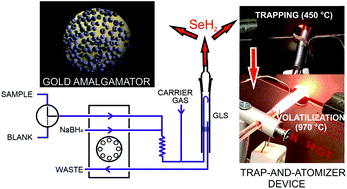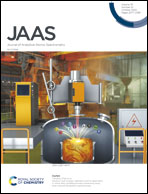Selenium preconcentration in a gold “amalgamator” after hydride generation for atomic spectrometry†
Abstract
A gold amalgamator, used conventionally for Hg vapor enrichment, is reported to preconcentrate Se after hydride generation. The optimum trapping and volatilization temperatures were 450 and 970 °C, respectively. Preconcentration processes are controlled by temperature only while the carrier gas composition remains unchanged (75 ml min−1 H2). This is a significant advantage compared to the approach reported previously based on gold wire, where Se preconcentration was controlled by both surface temperature and carrier gas composition. Moreover, the gold amalgamator offers higher capacity and better resistance to interference, at least by an order of magnitude. This approach to Se preconcentration is very well compatible with atomic absorption spectrometry using a modular trap-and-atomizer device reported recently. The limit of detection for 300 s sample introduction time reached 13 pg ml−1 Se (absolute LOD 247 pg Se). The method developed was validated by analysis of water certified reference materials. The mechanism of selenium hydride trapping was investigated employing a 75Se radioactive indicator. The potential of coupling the gold amalgamator trap to an inductively coupled plasma mass spectrometer was also investigated. However, severe transport losses of volatilized Se species occur between the heated amalgamator and the torch due to analyte condensation on colder surfaces, preventing routine use of this set-up.



 Please wait while we load your content...
Please wait while we load your content...